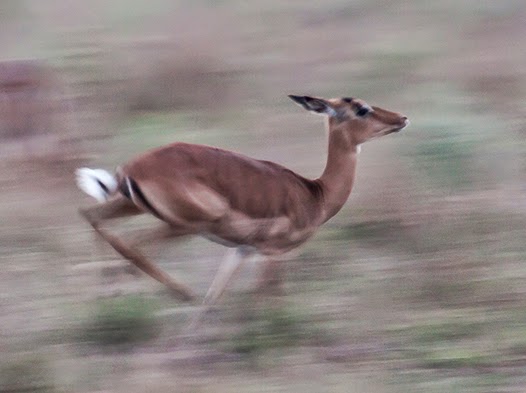That question is the logical end of a line of thinking
that started a couple of years ago during a photo safari in South Africa. It
came up again on a recent trip to Botswana. That led to some academic research
and ultimately the question about the state of wildlife -- and humans -- in the world today.
 |
| Wild giraffe in South Africa |
It all began as I rode around Kruger National Park with some
other photographers with an observation that if we drove every mile of road in
the park, we could see at best perhaps
five percent of the total land area, and therefore only the animals in that
five percent. We wondered if the animals in the other 95 percent behaved
differently from the ones we could see. We stopped wondering when we stopped to
photograph a family of giraffes browsing the trees near the road.
When the same conversation occurred two months ago in
Botswana, I wondered if anyone had done any serious research around the question. Indeed, a few people have. One of them, Dr. Colin Beale, on the
biology faculty at the University of York in England, was gracious enough to
respond to an e-mail.
 |
| A habituated lion |
Dr. Beale confirmed that research has shown that animals do "habituate"
to human presence in places like Kruger Park. Deeper investigation has led to
the idea that "not only ... animals in different parts of protected areas
may well behave differently, but that the very same individual animal may well
respond differently in different areas."
That suggests an even higher level of adaptation than I was not
expecting.
As for the latter question, about predators and prey
changing strategies to take advantage of human presence, I already knew the
answer, at least as it
applies to marine animals. Scuba divers who go down on
tropical reefs at night are familiar with the phenomenon of tarpon and other
large predators swimming beside them, all but invisible in the dark, and then
streaking out to nab a grunt that the diver's light exposed before it could
find a hidey hole in the reef. That is clearly learned behavior, or, as the
biologists would put it, evidence of "habituation."
 |
| Tarpon use divers' lights to help them hunt |
In Africa, we speculated about whether prey animals like
impala go on high alert when they see a traffic jam of safari vehicles. Any
safari client knows that such a traffic jam, or "lion jam," as Dr.
Beale puts it, means there's been a predator sighting. Could the antelopes have
learned that, too?
 |
| Lion and impala |
"Animals aren't silly and will take what cover they
can," Dr. Beale said. "I've never thought that prey might learn to
associate cars with predators, though, so guess that might be less of a
chance."
Okay, so maybe prey animals are not as smart as predators
(by our measures, at least). Maybe that's why they are prey. But hunters in
Virginia have long insisted that deer in the vicinity of Shenandoah National
Park seem to know when hunting seasons begins, as they seem to migrate into the
sanctuary of the park until hunting season ends.
 |
| Do impala know that a traffic jam means lions are about? |
The next question, of course, is so what? Does it matter?
Sure, humans have made impacts on the planet, many of them harmful. In recent
years, some people have tried to reverse some of the damage (see my recent blogpost about the ongoing recovery of the once endangered wood stork and other
wildlife).
Of course, when we try to restore the planet, we need to
know what we're restoring it to. Do we want to re-create the world before
humans invaded? Good luck with that. The bottom line is we have done damage and
much of it is permanent. With climate change and air and water pollution, our
reach extends even into areas beyond our reach. There is no wilderness any
more, nothing untouched by man.
 |
| Is he really wild? |
Human life depends upon wildlife and wild places. It's that
simple. The health of this great ecosystem known as Planet Earth depends upon
biodiversity. The addition of humans to this ecosystem should have enhanced
biodiversity, but the opposite has happened. We have accelerated the rate of
extinction beyond what the ecosystem can sustain. What we have not killed off
we have "habituated." Or is that just another form of extinction?
We need wild animals. We need wild places. We need places we
can not and do not touch. We need to protect the planet and its other inhabitants from us, for our own sakes.

Yes, we need to protect our planet
ReplyDelete